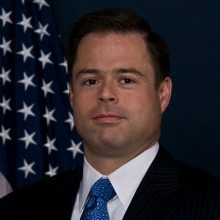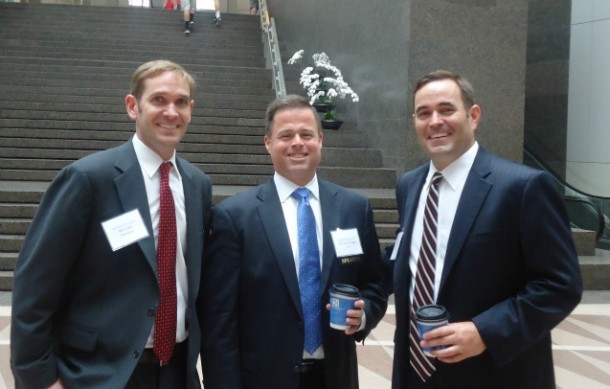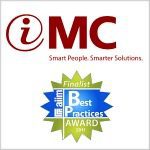
This year’s ACT-IAC’s 2015 Management of Change (MOC) Conference kicks off this Sunday, May 17 with the theme of “Hacking Culture through Innovation” and breakout topics like “The Elephant in the Room: Disrupting Status Quo” and “Preparing for the Next Wave of Disruption: From Internet of Things.”
WashingtonExec spoke with ACT-IAC’s President and 2015 MOC facilitator Dr. Rick Holgate, Assistant Director for Science & Technology/CIO, Bureau of Alcohol, Tobacco, Firearms & Explosives (ATF) about the event theme and more.
Read below to find out how Dr. Holgate plans to “break the historical habits of implementing traditional technology,” sign on more millennials to public service and why he cares about digital health.
WashingtonExec: How do you foster a culture of innovation at your agency, and how does it contribute to your success?
Dr. Rick Holgate: We’ve fostered a culture of innovation by identifying and encouraging employees who possess the critical qualities of an innovator: creativity, to see the possibilities of technology, without being constrained by tradition or “the way we’ve always done things”; fearlessness, to speak up and propose an adventurous new path to a new solution, with the courage to withstand skeptics and to respond constructively to doubt; and persistence, to have the passion for the positive impacts they foresee and to see it through to success, without being easily deterred by the unknown, or temporary setbacks, or naysayers.
We found numerous and occasionally unlikely sources of innovation from all parts of our organization and all levels of our people – to include, for example, a GS-13 member of our technical staff and a GS-15 operational partner. We didn’t turn them away, we encouraged them to come to us with their ideas, helped them refine them into a tangible and achievable set of initiatives, and gave them the support to move forward with a minimum of obstacles or distractions. In practice, sources of innovation can contribute substantially to organizational success – breaking the historical habits of implementing “traditional” technology, accelerating the pace of adoption of new technologies and new approaches, and bringing a fresh perspective into how we approach business and mission challenges.

WashingtonExec: What are the biggest challenges agencies are facing in the modern workforce, and how can they overcome those challenges?
Dr. Rick Holgate: As many have mentioned, our biggest challenges are addressing an aging workforce and associated attrition – in our case, our workforce averages over age 50 and has an impending wave of retirement. While we can’t project a specific wave of retirement, we can and must recognize that it’s inevitable and plan accordingly. At the same time, millennials constitute a disproportionately underrepresented segment of our federal workforce – an egregious condition we need to work hard to rectify. Attracting and retaining millennials must be an overarching priority in constructing our workforce of the future. Improving our recruitment techniques and maximizing our hiring authorities are two key initiatives, but we can and must redouble our efforts to become a workplace of choice for the next generation.
WashingtonExec: How can adopting continuous delivery as a strategy benefit organizations in the current market?
Dr. Rick Holgate: We’ve seen the abundant benefits already: by adopting it as a strategy – and moreover making it a reality – continuous delivery improves organizational credibility by demonstrating tangible progress and achievements; enhances agility by avoiding locking in multi-year, inflexible projects and allowing flexibility to respond to evolving conditions and markets; improves morale by making delivery teams more dynamic and less encumbered by the drudgery of long-term project “death marches;” and ensures continued organizational relevance. Some of the continuous delivery “poster children” – Google, Amazon, Facebook, among a few – have become the talent pool for 18F and the US Digital Service. Those firms have unequivocally proved the quintessential benefit of continuous delivery – and the Darwinian need in the current market to “evolve (faster) or perish.” USDS and 18F have led the charge in the cultural shift in the federal government to adopt the same sense of urgency behind everything we do.
WashingtonExec: Besides consumer applications, how do you see IOT changing the technological landscape in the coming years? How will this growing trend benefit industry and government?
Dr. Rick Holgate: IOT will certainly affect – and almost assuredly transform – the emerging cyber security landscape. The explosion of connected devices will clearly influence our perception(s) of threats and definition(s) of an appropriate cyber security regimen. But the practical and innovative application of IOT will far outweigh the security risks and pressures. Living an instrumented life will become natural: for “digital health” (health monitoring, healthy lifestyle adoption and shared caregiving); for public safety (shedding privacy concerns in favor of shared awareness of and response to threats, “blue force” tracking, and omnipresent sensors); and for continued pervasiveness of social and commerce applications and convenience (Amazon Dash Button, anyone?). In short, IOT extends the disruptive effect of technology in new, and differently enabling, ways – lowering the barrier of distributing services universally and seamlessly.
WashingtonExec: What do you see as the biggest factor in change resistance, and how can government break through that barrier?
Dr. Rick Holgate: Institutional, cross-disciplinary inertia is the biggest factor. An excessive level of comfort with the status quo; an unnatural fear of disrupting the old order with new ideas; a compliance-minded reluctance to doing things any way but “by the book”; a restrictive interpretation of what’s permissible – they all add up to inertia, with multiple disciplines (contracting officers, IT professionals, financial managers, HR personnel) contributing. Breaking through the inertia will require coordinating or orchestrating evolution across disciplines.
The Digital IT Acquisition Professional program is one example; the composition of the ACT Executive Committee and Executive Advisory Council is another; and the “quad council” (involving CIOs, CAOs, CFOs, CHCOs) approach is one whose time is long overdue.
WashingtonExec: What are you most looking forward to at MOC 2015?
Dr. Rick Holgate: Divergent perspectives; a dynamic program featuring though-provoking speakers; radical techniques for designing and conceiving sessions; all with an objective of collaborating on “hacking culture” to infuse organizational innovation. What am I most looking forward to? “All of the above!”
Related: FCW Announces 2015 Federal 100, Includes Ken Asbury, Jon Johnson and Kay Kapoor


